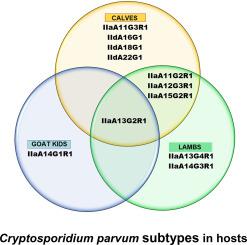Parasitology International ( IF 1.9 ) Pub Date : 2020-06-24 , DOI: 10.1016/j.parint.2020.102163 Mohammad Hazzaz Bin Kabir 1 , Onur Ceylan 2 , Ceylan Ceylan 2 , Ayman Ahmed Shehata 3 , Hironori Bando 4 , Mohamed Ibrahim Essa 5 , Xuenan Xuan 6 , Ferda Sevinc 2 , Kentaro Kato 7

|
The studies on Cryptosporidium infections of animals in Turkey mostly rely on microscopic observation. Few data are available regarding the prevalence of Cryptosporidium genotypes and subtypes infection. The aim of this study is to analyse the detection of Cryptosporidium genotypes and subtypes from young ruminants. A total of 415 diarrheic fecal specimens from young ruminants were examined for the Cryptosporidium detection by use of nested PCR of the small subunit ribosomal RNA (SSU rRNA) gene and the highly polymorphic 60 kDa glycoprotein (gp60) gene followed by sequence analyses. The results of this study revealed that 25.6% (106 of 415) of the specimens were positive for Cryptosporidium spp. infection. We identified 27.4% (91/333), 19.4% (13/67), and 13.4% (2/15) of positivity in calves, lambs and goat kids, respectively. Genotyping of the SSU rRNA indicated that almost all positive specimens were of C. parvum, except for one calf which was of C. bovis. Sequence analysis of the gp60 gene revealed the most common zoonotic subtypes (IIa and IId) of C. parvum. We detected 11 subtypes (IIaA11G2R1, IIaA11G3R1, IIaA12G3R1, IIaA13G2R1, IIaA13G4R1, IIaA14G1R1, IIaA14G3R1, IIaA15G2R1, IIdA16G1, IIdA18G1, IIdA22G1); three of them (IIaA12G3R1, IIaA11G3R1 and IIaA13G4R1) was novel subtypes found in calves and lambs. Additionally, three subtypes (IIaA11G2R1, IIaA14G3R1, and IIdA16G1) were detected in young ruminants for the first time in Turkey. These results indicate the high infection of Cryptosporidium in Turkey and propose that young ruminants are likely a major reservoir of C. parvum and a potential source of zoonotic transmission.
中文翻译:

土耳其腹泻小牛,羔羊和山羊羔的隐孢子虫感染基因型和亚型的分子检测。
土耳其动物隐孢子虫感染的研究主要依靠显微镜观察。关于隐孢子虫基因型和亚型感染的流行率,尚无可用数据。这项研究的目的是分析从年轻反刍动物中隐孢子虫基因型和亚型的检测。使用小亚基核糖体RNA(SSU rRNA)基因和高度多态的60 kDa糖蛋白(gp60)基因的巢式PCR,对来自年轻反刍动物的总共415份腹泻粪便样本进行了隐孢子虫检测,然后进行了序列分析。这项研究的结果表明,有25.6%(415的106)的样本隐孢子虫呈阳性spp。感染。我们确定小牛,羔羊和山羊羔羊的阳性率分别为27.4%(91/333),19.4%(13/67)和13.4%(2/15)。的SSU rRNA基因的基因分型显示,几乎所有的阳性标本的微小隐孢子虫,除了一个小牛比增C.牛。gp60基因的序列分析显示了小球藻的最常见的人畜共患亚型(IIa和IId)。我们检测到11个亚型(IIaA11G2R1,IIaA11G3R1,IIaA12G3R1,IIaA13G2R1,IIaA13G4R1,IIaA14G1R1,IIaA14G3R1,IIaA15G2R1,IIdA16G1,IIdA18G1,IIdA22G1;其中三个(IIaA12G3R1,IIaA11G3R1和IIaA13G4R1)是在小牛和羔羊中发现的新型亚型。此外,在土耳其首次在年轻反刍动物中发现了三种亚型(IIaA11G2R1,IIaA14G3R1和IIdA16G1)。这些结果表明土耳其隐孢子虫感染率很高,并表明年轻的反刍动物可能是小隐孢子虫的主要贮藏库和人畜共患病传播的潜在来源。


























 京公网安备 11010802027423号
京公网安备 11010802027423号